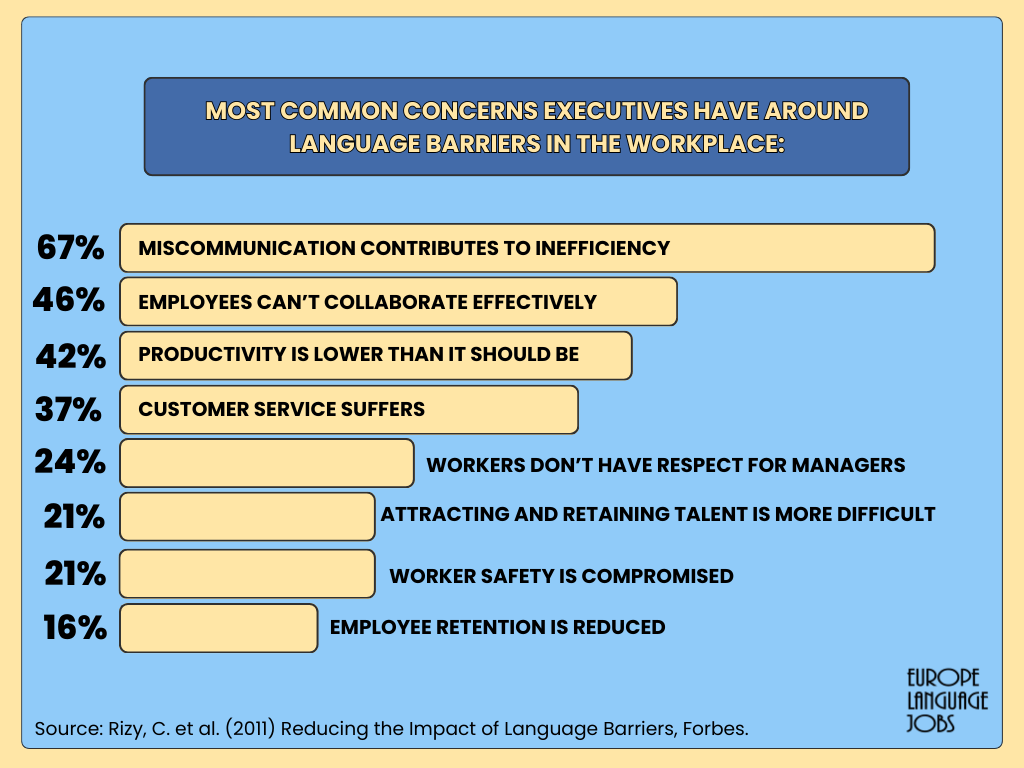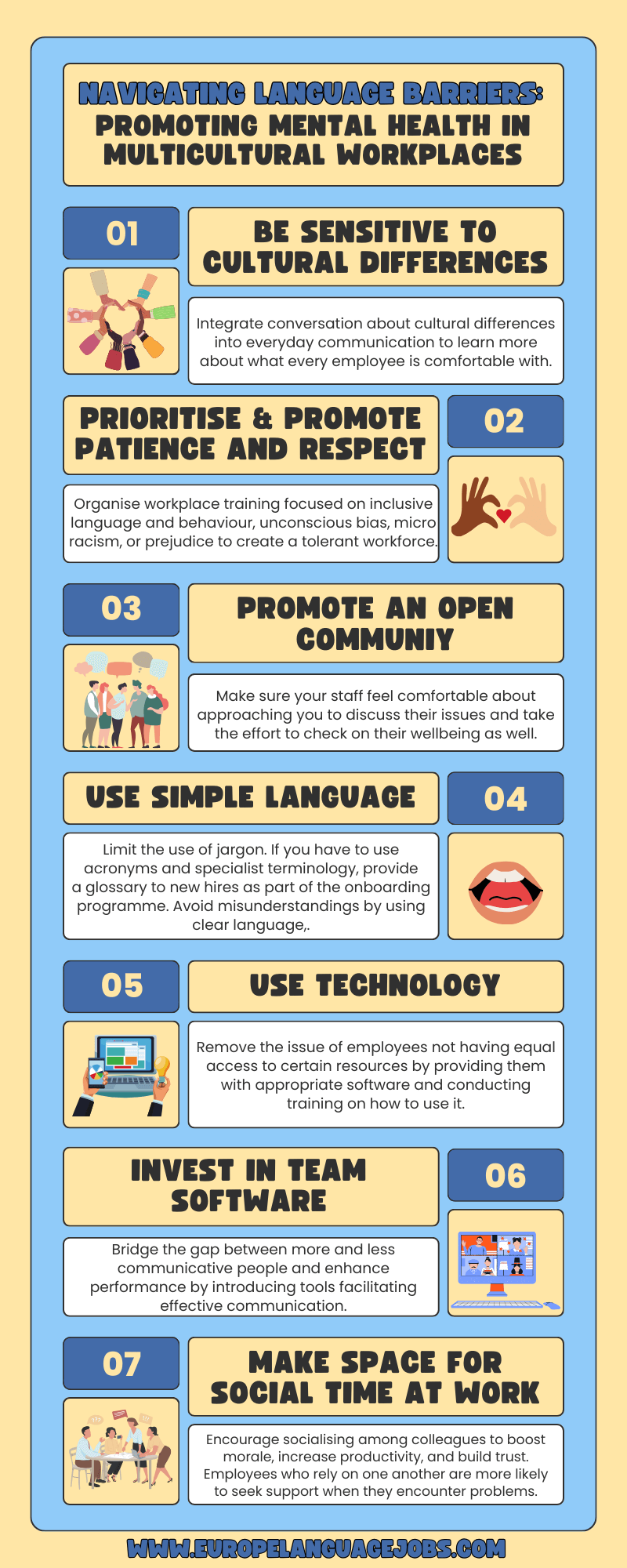As society progresses, we are seeing an increase in dynamic, vibrant and diverse representations in our communities - on our screens, in industry, and in our workplaces.
Whilst diversification is undoubtedly a positive and enriching step forward for all parties, we need to also consider how the experiences of people are not always the same.
Each individual brings something different to a team which every workplace comprising of a wide range of skills, experience, identities and cultural beliefs. This is a huge benefit for society as well as for the individual workplace, with Forbes identifying that ‘the best way to ensure the development of new ideas is through a diverse and inclusive workforce.’ [1]
But for multicultural workplaces to function well, they need to address any barriers that might stand in the way.
There may be some demographics that are directly or indirectly privileged for a number of reasons. It is our role to take an active position in this and consider the ways in which some demographics may face systematic barriers at work.
Once we are able to identify the negative impact of these, we can consider the ways in which we can alter the ways we work to ensure these are minimised. One of the biggest things to consider is the impact of language diversity, particularly how the gap between official and non-native language in the workplace can risk alienating particular groups.
We live in a multicultural society, a society characterised by a range of different races, cultures and nationalities. This has been indebted to the increasing globalisation and a more connected world which allows societies to become more diverse and thrive in the process of doing so.
However, sociological perspectives suggest that a more varied society does not always mean an equal one, with some sociologists indicating that we need to consider multiculturalism not as a concept but as a kind of philosophy or political ideology. In this context, multiculturalism is not just defined by varied populations, but:
a 'view that culture, races, and ethnicities, particularly those of minority groups, deserve special acknowledgement of their differences within a dominant political culture.' [2]
This means that a multicultural society is not always inherently equal; indicating that measures need to be put in place to even out any regulations, rules and both implicit or explicit practices that can alienate through prejudice against people.
Some of the barriers that can be experienced within the multicultural workplace are:
· Risk of prejudice or pervasive stereotypes
· Conflicting working styles related to previous work experiences and environments
· Conflicting understandings of professionalism and 'work etiquette'
· Navigating work requirements related to international employment laws
· Other voices being heard over others
· Miscommunication, misinterpretation or misunderstanding due to language barriers (either due to language itself or cultural norms of humour, irony, etc)
Among these barriers to multicultural workplaces, perhaps the most pervasive is the language barrier that can be linked to multilingualism.
- The Impact of Language Barriers in the Workplace
- The Consequences of Language Barriers
- What Does That Mean for Mental Health?
- How Language Barriers Can Harm
- Ways to Navigate Cultural Barriers: Steps to Respect Cultural Diversities at Work
- Accessing Mental Health Support
The Impact of Language Barriers in the Workplace
What is a Language Barrier?
A language barrier typically occurs when there is a 'difference in the native language,' between two or more people in conversation. [3]
It can also, however, refer to the barriers between individuals with different communication styles in relation to neurodiversity or hearing impairments. [4] The impact of language barriers has been particularly discussed in the context of medical settings and health professionals when considering the connection between successful conversation and patient safety. However, these barriers can exist in any work context.
The Consequences of Language Barriers
An article published by Forbes identifies that in 'an increasingly global economy' companies 'will perform better by hiring individuals who can communicate in foreign languages.' [5] However, in a joint study looking at language disparity in the workplace conducted with 'experts in language learning' Rosetta Stone, the article identified a range of issues that can arise from language barriers at work.
It did this by surveying over 100 executives in the US, asking them to make comment on any concerns they had around language barriers at work.

The responses included:
· concerns that 'miscommunication contributes to inefficiency' (67%)
· concerns that miscommunication means 'employees can't collaborate effectively' (46%) · concerns that 'productivity is lower than it should be' (42%)
· concerns that 'customer service suffers' (37%)
· concerns that 'workers don't have necessary respect for managers/executives' (24%)
· concerns that 'attracting and retaining talent is more difficult' (21%)
· concerns that 'worker safety is compromised' (21%)
· concerns that 'employee retention is reduced' (16%) [6]
Whilst all these concerns are valid from the perspective of an individual running a business, it is perhaps alarming to note that only of these concerns - about worker safety - was regarding the experience of the individual employee.
This suggests that a significant shift is required to consider the way that language barriers not only impact the efficacy of the business model, but how they may negatively impact the individual's experience in the workplace.
What Does That Mean for Mental Health?
Not properly addressing any racial disparities in the workplace may mean that there are particular individuals in employment who do not feel as welcome, comfortable or connected at work.
Unfortunately, power dynamics between individuals who speak the company's preferred language natively and individuals who speak it as a second language are likely to experience the workplace in different ways.
This can be related to systematic issues, such as white privilege, differences in language proficiency and exposure to certain workstyles and software. [7]
1 in 8 people of working age are from a BME (black or minority ethnic background). Of these people, individuals from BME groups 'are more likely to be overqualified than white ethnic groups', however white individuals are 'more likely to be promoted then all other groups.' [8]
How Language Barriers Can Harm
This information is likely to breed concerns over which groups are privileged and which groups are able to use their voices in order to access support, training and career progressions than others.
Individuals who experience language barriers at work are more likely to feel alienated in their workplace. This alienation can happen directly or indirectly can lead to an uncomfortable work culture which is frequently linked back to communication issues, particularly between native and ESL (English as a second language) speakers. [9]
This can be due to any of the following:
· Having limited ability or feeling unable to socialise and bond with other members of the workforce
· Having different cultural values which may lead to being generally quieter or less vocal with ideas and concepts or in social situations without directly being addressed
· Feeling as though ideas are not listened to or are attributed to someone else in the workforce
· Misunderstanding and needing clarification but being anxious to do so
These can contribute to feeling very anxious in the workplace. Almost half (49%) of black and minority ethnic individuals cite work stress as a contributing factor to mental health issues compared to 39% of white employees. [10]
Secondly, only 40% of individuals from black or minority ethnic backgrounds feel comfortable talking about mental health at work. [11]
This suggests the risk of a communication desert that could leave the work and support needs of specific demographics being significantly unmet. This in itself is likely to link to a decrease in job satisfaction and alienation at work.
Ways to Navigate Cultural Barriers: Steps to Respect Cultural Diversities at Work

We must work towards an environment where '[f]ully inclusive workplaces are the target' for all individuals. [12] There are several methods of addressing this.
- Be Sensitive to Cultural Differences
- Prioritise (and Promote) Patience and Respect
- Promote an Open Community
- Use Simple Language
- Use Technology
- Invest in Communication & Team Software
- Make Space for Social Time at Work

1. Be Sensitive to Cultural Differences
All members of staff have a right to feel comfortable and welcomed in their workplaces. For this to happen, however, cultural differences need to be respected. Take time to learn about your staff and colleagues.
If they are comfortable in doing so, speak to them about their previous work experiences and what they found most helpful in past roles.
This can be integrated into everyday conversation in the workplace.
For example, when discussing holidays or calendar events, be mindful that these holidays may only be significant to your country of origin; ensure that you are open to the discussion of diverse calendar events to make sure that you are not positing one cultural preference over another and everyone feels able to join in with fun conversations.

2. Prioritise (and Promote) Patience and Respect
You can learn to ensure your language and behaviour are as sensitive as possible through workplace training. There are training programmes on topics such as unconscious bias that will educate your staff team on how prejudice can function on different levels. [13]
Understanding bias and prejudice as insidious forces that need to be expelled ultimately models a tolerant and open workforce that prioritises inclusion. Having such discussions as part of your onboarding and training processes can ensure that employees feel comfortable that you are committed to respect from an early stage as well as indicating a low tolerance for prejudice in the workplace.

3. Promote an Open Community
Often people feel that they can not speak up to ask for what they need. In the workplace, you have the responsibility to model open and honest behaviour.
Reassure your team that queries are both appropriate and welcome to ensure they feel more confident in asking for support.
Equally, you can also approach staff yourself; from an employment perspective, you have the capacity to ask individuals what they are struggling with in the workplace in order to ascertain what reasonable adjustments can be made to support them. This is not only likely to increase productivity, but will also promote a happier and more confident workforce.
This can be heightened by the fact that in some 'minority ethnic communities, mental health problems are rarely spoken about and can be seen in a negative light.' [14] For this reason, it is essential for open and honest conversations about wellbeing in the workplace to become more commonplace.

4. Use Simple Language
One of the main things you can do to make sure the work context is not marred by language barriers is by limiting the amount of jargon you use.
Linguists have identified that jargon is often a key part of the 'coding' or a particular work context. For example, doctors will encounter different jargon to lawyers or construction workers, etc. [15]
Sometimes this is difficult to avoid, but one of the best ways to do this is to think carefully about your language use. Do you have to use acronyms? If you do, is it possible to provide a glossary to new starters that explains these acronyms?
Can your language itself be made clearer, more punchy and direct, with less metaphors, irony or undertones that can risk changing the meaning of what you are saying?

5. Use Technology
You may find that multicultural workplaces naturally mean that some groups have more access to resources than others. Providing specific technology - and, essentially, the training to allow people to use this software appropriately - can work to level out some of the gaps in access that language barriers cause.
Think carefully about the work your team is providing and do some research into what types of technical innovations can support and enhance their
working experiences.

6. Invest in Communication & Team Software
If you find that communication in the workplace is a key issue, then team software may be an essential investment. Using group bulletin boards, forums or spreadsheets can mean that the team can collaborate digitally.
This can be used to allocate work or check in on deadlines, to ask queries of other team members or to establish new team activities.
This can help to bridge the gaps between people who are willing to speak and others who may feel less able to do so.
Collaborative tech can be a method of ensuring everyone's voice is heard and may even streamline standard work processes whilst doing so.

7. Make Space for Social Time at Work
Often work is so busy that it is no wonder that there is no time to get to know one another. However, there are many benefits to committing some time to socialising in the workplace. It can help to increase morale, establish connections and reduce tension.
Developing these relationships is likely to encourage some people to talk more and others to learn about how to make spaces for individuals around them. It can also be a helpful way of creating connections that can be utilised when things get tough and employees may need a colleague to chat to.
Accessing Mental Health Support
If you are struggling with mental health in the workplace, it’s essential that you know where to turn if things get tough.
If experiences at work are causing you significant distress or your mental health is making your time at work tricky, you could reach out to:
· Trusted friends and family
· A colleague
· A community support group
· Your GP or other primary care clinician
· Social services
· Emergency support lines
· Specialist mental health and addiction services
You can always think about getting in touch with helplines such as Rehab Recovery or Young Minds. These are specialist services that focus on providing mental health and addiction support.
References
[1] https://images.forbes.com/forbesinsights/StudyPDFs/Innovation_Through_Diversity.pdf
[2] https://www.britannica.com/topic/multiculturalism
[3] https://www.ncbi.nlm.nih.gov/books/NBK507819/
[4] https://web.archive.org/web/20210627102823id_/https://prod-com-bibliolabs-nuvique-app-content.s3.amazonaws.com/SID-0000003307785/SID-0000003307785.pdf?X-Amz-Security-Token=IQoJb3JpZ2luX2VjEID%2F%2F%2F%2F%2F%2F%2F%2F%2F%2FwEaCXVzLWVhc3QtMSJGMEQCIDCKTZgHUsKyjP57mn7E419SJnVBeCdZl5ut4K1i4euYAiBgt0E8tgZteDgM1xFHDhxR2C9cbsXWQ4zilM%2BhkLVspSr3AwhZEAAaDDAwNjg0ODA5MTAxNCIMZ5GA%2FIccAjDkWBGDKtQDsEWxo2%2BTmeBXp0QwP2dPQAvgJzn7%2BHnwjYJJtofLzU7BRjX0Wspu6ITvzUoS0AQJvkTHccz610NH2n7AAnup3qsN%2BjKWaPjkgLYtThXgaUssfMlJrmC3W67qaUOGVWu5I%2FsINnIkA0waQ6mxOdY632reRy1smpC75E4WAE9ZNq%2F2d1YVAs4afGSyeua%2FczfNfeT8knu1i%2BXZMUlA7MdPdNE4JHu3KfsFjDUbhi5UaOwoDSsqkJeOCNUmqhMtaJcb6qn8MqnJ4aVPcJ5U1svZfUhTyZ04sfW8aJuPtZWBRM5Cm6CuIh87T7IIGPfsmdkhdGzlQAqLdvHbmEEYMNGxkw4EgpXr7bmaLh%2BwpgOH8CPbyCprOB34ybI8HRF6i9p1oNi9NLL6UGqcZeWK2DbHRytRHo2plkTUnG2aW9D35prjhk0dqvGGWw7zxhzX8%2F0x8vgd9HOIDSnHv0BL5rAlziDI90vYD10YpH0XbBDXVfxsmvrBO%2B5sY9V0P6N3U%2FS2l9Kaih%2FzwmzGCHYzOl%2F6ZUPeVBRLmgxH0N2AfQiXJEH7ECkJr8iHHhf0oCkRZ9fpQIhLt%2B3esTbpDWdJcw7KVZHiEW2D9IpNN9nYbkY55jACFBDIMLra4IYGOqYBQ0kxS8eoD2t9803N5aA0P3USoxG2CibhADJCVPEMTHmTrs5mQrnt1Y92ff0mEO061w6AfB5Kxp34RnOGBriKjTgmpZ8DAQIr3aZVGOvG%2BbU8X8uRTayNuLs%2F4t9bxgmbCMsIgw8t6PhMBWIsP%2FShH%2FaWff5PONp1NcMCScahKysTqzTbBdmnQTztG0psuxzmk7wlBlmFID7EyNIGPUjHt0HCOz78dA%3D%3D&X-Amz-Algorithm=AWS4-HMAC-SHA256&X-Amz-Date=20210627T102710Z&X-Amz-SignedHeaders=host&X-Amz-Expires=120&X-Amz-Credential=ASIAQDGBNSODH2ZBYS64%2F20210627%2Fus-east-1%2Fs3%2Faws4_request&X-Amz-Signature=9aa70776012038be6d02a939bad9a7d4e47c788bb3d872164b51889e16f0d654#page=106
[5]https://images.forbes.com/forbesinsights/StudyPDFs/Rosetta_Stone_Report.pdf
[6]https://images.forbes.com/forbesinsights/StudyPDFs/Rosetta_Stone_Report.pdf
[7] https://assets.publishing.service.gov.uk/media/5a7f81c6ed915d74e33f6dc4/race-in-workplace-mcgregor-smith-review.pdf
[8]https://assets.publishing.service.gov.uk/media/5a7f81c6ed915d74e33f6dc4/race-in-workplace-mcgregor-smith-review.pdf
[9] https://www.researchgate.net/publication/346459711_ESL_Learners'_Sense_of_Alienation_An_Exploratory_Mixed_Method_Research_on_the_Role_of_ESL_Teachers'_Remarking_Practices
[10] https://www.researchgate.net/publication/346459711_ESL_Learners'_Sense_of_Alienation_An_Exploratory_Mixed_Method_Research_on_the_Role_of_ESL_Teachers'_Remarking_Practices
[12] https://www.bitc.org.uk/wp-content/uploads/2020/06/bitc-factsheet-race-raceandmentalhealthatwork-march2020.pdf
[13] https://www.bitc.org.uk/wp-content/uploads/2020/06/bitc-factsheet-race-raceandmentalhealthatwork-march2020.pdf
[14] https://assets.publishing.service.gov.uk/media/5a7f81c6ed915d74e33f6dc4/race-in-workplace-mcgregor-smith-review.pdf
[15] https://discovery.ucl.ac.uk/id/eprint/10059212/1/Krouglov_Interaction%20of%20professional%20jargon%20and%20linguistic%20identity_AAM.pdf

















Tashmoye Smile-Perrier 11mo ago
I enjoyed this. It’s really beneficial and supportive. This is something that is real and we need to be knowledgeable of it.
I enjoyed this. It’s really beneficial and supportive. This is something that is real and we need to be knowledgeable of it.